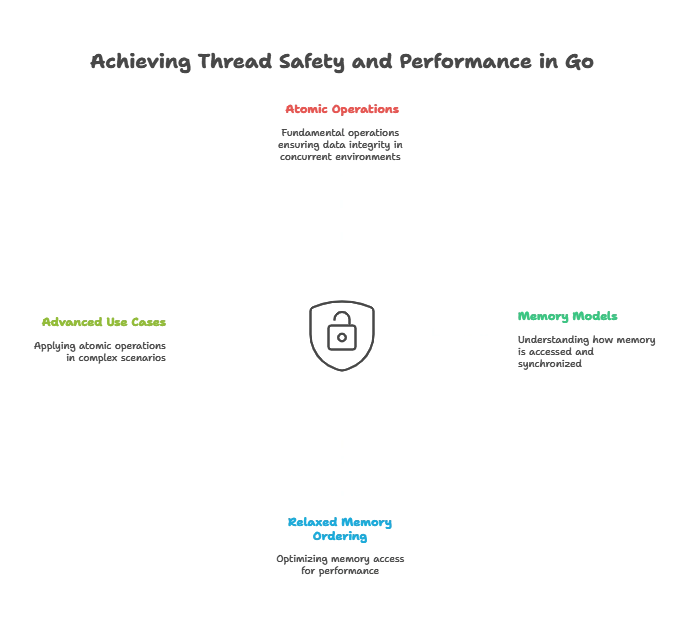Atomic Operations in Go
In Go, atomic operations are fundamental for ensuring safe concurrent access to shared variables across goroutines. Atomic operations guarantee that certain operations on variables are executed indivisibly without interference from other goroutines. Understanding atomic operations is crucial for writing concurrent programs that avoid race conditions and ensure data integrity.
Basics of Atomic Operations
What are Atomic Operations?
Atomic operations are operations that are performed as a single indivisible step, without interruption. In Go, the sync/atomic package provides functions for atomic operations on basic types like integers and pointers.
package main
import (
"fmt"
"sync"
"sync/atomic"
)
func main() {
var count int64
// Increment the count atomically
atomic.AddInt64(&count, 1)
fmt.Println("Count after increment:", count)
// Compare-and-swap operation
old := atomic.LoadInt64(&count)
new := old + 1
swapped := atomic.CompareAndSwapInt64(&count, old, new)
fmt.Println("Swapped:", swapped)
}
OUTPUT
Count after increment: 1
Swapped: true
In this example, atomic.AddInt64() increments the count variable atomically by 1, and atomic.CompareAndSwapInt64() performs a compare-and-swap operation, swapping the value of count if its current value matches the old value.
Working with Atomic Operations
Use Cases of Atomic Operations
Atomic operations are commonly used for implementing synchronization primitives like locks, implementing concurrent data structures, and ensuring safe access to shared variables in concurrent programs.
Example:Implementation a Concurrent Counter
package main
import (
"fmt"
"sync"
"sync/atomic"
)
func main() {
var counter int64
var wg sync.WaitGroup
numIterations := 1000
wg.Add(numIterations)
for i := 0; i < numIterations; i++ {
go func() {
defer wg.Done()
atomic.AddInt64(&counter, 1)
}()
}
wg.Wait()
fmt.Println("Counter value:", atomic.LoadInt64(&counter))
}
In this example, multiple goroutines concurrently increment a counter using atomic.AddInt64() to ensure safe access to the shared variable counter.
Advanced Concepts
Memory Ordering with Atomic Operations
Atomic operations also provide memory ordering guarantees, ensuring visibility of changes across different goroutines. The sync/atomic package provides memory ordering options like memoryOrderSeqCst, memoryOrderAcquire, and memoryOrderRelease to control memory access orderings.
Example:Memory Ordering
package main
import (
"fmt"
"sync"
"sync/atomic"
)
func main() {
var flag int32
var value int32
var wg sync.WaitGroup
wg.Add(2)
go func() {
defer wg.Done()
atomic.StoreInt32(&value, 42)
atomic.StoreInt32(&flag, 1)
}()
go func() {
defer wg.Done()
for atomic.LoadInt32(&flag) == 0 {
// Wait until the flag is set
}
fmt.Println("Value:", atomic.LoadInt32(&value))
}()
wg.Wait()
}
In this example, the flag variable is used to synchronize the access to the value variable. The LoadInt32() and StoreInt32() functions ensure proper memory ordering.
Atomic Operations and Memory Models
Understanding memory models is crucial for correctly utilizing atomic operations. Go follows the “happens-before” memory model, which defines the ordering of memory accesses between goroutines. Atomic operations play a significant role in ensuring memory visibility and consistency across goroutines.
Sequential Consistency vs. Relaxed Memory Ordering
The sync/atomic package provides functions with different memory ordering semantics. Sequential consistency ensures that all operations appear to be executed in a consistent order, while relaxed memory ordering provides more relaxed guarantees about memory access ordering.
Example: Memory Ordering
package main
import (
"fmt"
"sync"
"sync/atomic"
)
func main() {
var flag int32
var value int32
var wg sync.WaitGroup
wg.Add(2)
go func() {
defer wg.Done()
atomic.StoreInt32(&value, 42)
atomic.StoreInt32(&flag, 1)
}()
go func() {
defer wg.Done()
for atomic.LoadInt32(&flag) == 0 {
// Wait until the flag is set
}
fmt.Println("Value:", atomic.LoadInt32(&value))
}()
wg.Wait()
}
In this example, the flag variable is used to synchronize access to the value variable. The LoadInt32() and StoreInt32() functions ensure proper memory ordering, preventing data races and ensuring memory visibility between goroutines.
Advanced Use Cases of Atomic Operations
Atomic operations can be used in advanced scenarios such as implementing lock-free data structures, fine-grained synchronization mechanisms, and high-performance concurrent algorithms. These techniques require a deep understanding of atomicity, memory models, and concurrent programming principles.
Example: Lock-Free Stack Implementation
package main
import (
"fmt"
"sync/atomic"
"unsafe"
)
type Node struct {
value int
next *Node
}
type Stack struct {
top unsafe.Pointer
}
func NewStack() *Stack {
return &Stack{}
}
func (s *Stack) Push(value int) {
newNode := &Node{value: value}
for {
oldTop := atomic.LoadPointer(&s.top)
newNode.next = (*Node)(oldTop)
if atomic.CompareAndSwapPointer(&s.top, oldTop, unsafe.Pointer(newNode)) {
return
}
}
}
func (s *Stack) Pop() (int, bool) {
for {
oldTop := atomic.LoadPointer(&s.top)
if oldTop == nil {
return 0, false
}
node := (*Node)(oldTop)
newTop := atomic.LoadPointer((*unsafe.Pointer)(unsafe.Pointer(&node.next)))
if atomic.CompareAndSwapPointer(&s.top, oldTop, newTop) {
return node.value, true
}
}
}
func main() {
stack := NewStack()
stack.Push(1)
stack.Push(2)
stack.Push(3)
for {
value, ok := stack.Pop()
if !ok {
break
}
fmt.Println("Popped value:", value)
}
}
In this example, a lock-free stack data structure is implemented using atomic operations (CompareAndSwapPointer) to ensure thread safety without using traditional locks or mutexes. This demonstrates advanced usage of atomic operations in building concurrent data structures.

Atomic operations provide powerful mechanisms for synchronization and thread safety in Go programming. By understanding advanced topics such as memory models, relaxed memory ordering, and advanced use cases, you can leverage atomic operations effectively to build high-performance, concurrent applications that are free from race conditions and deadlocks. Continuing to explore and experiment with these concepts will deepen your understanding and mastery of concurrent programming in Go. Happy coding !❤️
